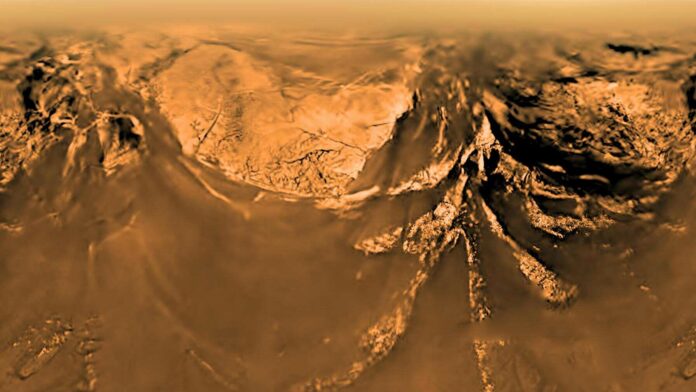Saturn’s largest moon, Titan, possesses an atmosphere and surface rich in organic compounds. Additionally, it harbors a subsurface liquid water ocean, making it a potential habitat for life.
In a recent study, researchers from the University of Western Ontario investigated the organic material transported from Titan’s surface to its ocean through impact cratering. They examined how impact craters on Titan might create melt deposits containing liquid water, estimating the number of organic molecules that could be trapped within these melt lenses.
Their findings suggest that Titan’s subsurface ocean is unlikely to support life despite its potential as a habitat due to its liquid water.
Western astrobiologist Catherine Neish said, “Unfortunately, we will now need to be a little less optimistic when searching for extraterrestrial lifeforms within our own Solar System. The scientific community has been very excited about finding life in the icy worlds of the outer solar system, and this finding suggests that it may be less likely than we previously assumed.”
Scientists measured the amount of organic molecules transferred from Titan’s surface to its subsurface ocean using data from impact cratering.
Throughout Titan’s history, comets colliding with the moon have melted its icy surface, forming pools of liquid water mixed with surface organics. The resulting melt, denser than the ice crust, sinks through the ice, possibly reaching Titan’s subsurface ocean.
By estimating the rates of impacts on Titan’s surface, the team calculated how many comets of varying sizes would hit Titan annually over time. This helps them to predict the flow rate of water containing organics moving from Titan’s surface to its interior.
Their analysis revealed that the weight of organics transferred in this manner is relatively small, amounting to no more than 7,500 kg/year of glycine – the simplest amino acid constituting proteins in life.
“This work shows that it is tough to transfer the carbon on Titan’s surface to its subsurface ocean – basically, it’s hard to have both the water and carbon needed for life in the same place,” said Neish.
“Even if the subsurface ocean isn’t habitable, we can learn a lot about prebiotic chemistry on Titan, and Earth, by studying the reactions on Titan’s surface,” said Neish. “We’d really like to know if interesting reactions are occurring there, especially where the organic molecules mix with liquid water generated in impacts.”
“If all the melt produced by impacts sinks into the ice crust, we wouldn’t have samples near the surface where water and organics have mixed. These are regions where Dragonfly could search for the products of those prebiotic reactions, teaching us about how life may arise on different planets,” said Neish.
“The results from this study are even more pessimistic than I realized with regards to the habitability of Titan’s surface ocean, but it also means that more interesting prebiotic environments exist near Titan’s surface, where we can sample them with the instruments on Dragonfly.”
Journal Reference:
- Catherine Neish, Michael J. Malaska et al. Organic Input to Titan’s Subsurface Ocean Through Impact Cratering. Astrobiology. DOI: 10.1089/ast.2023.0055
